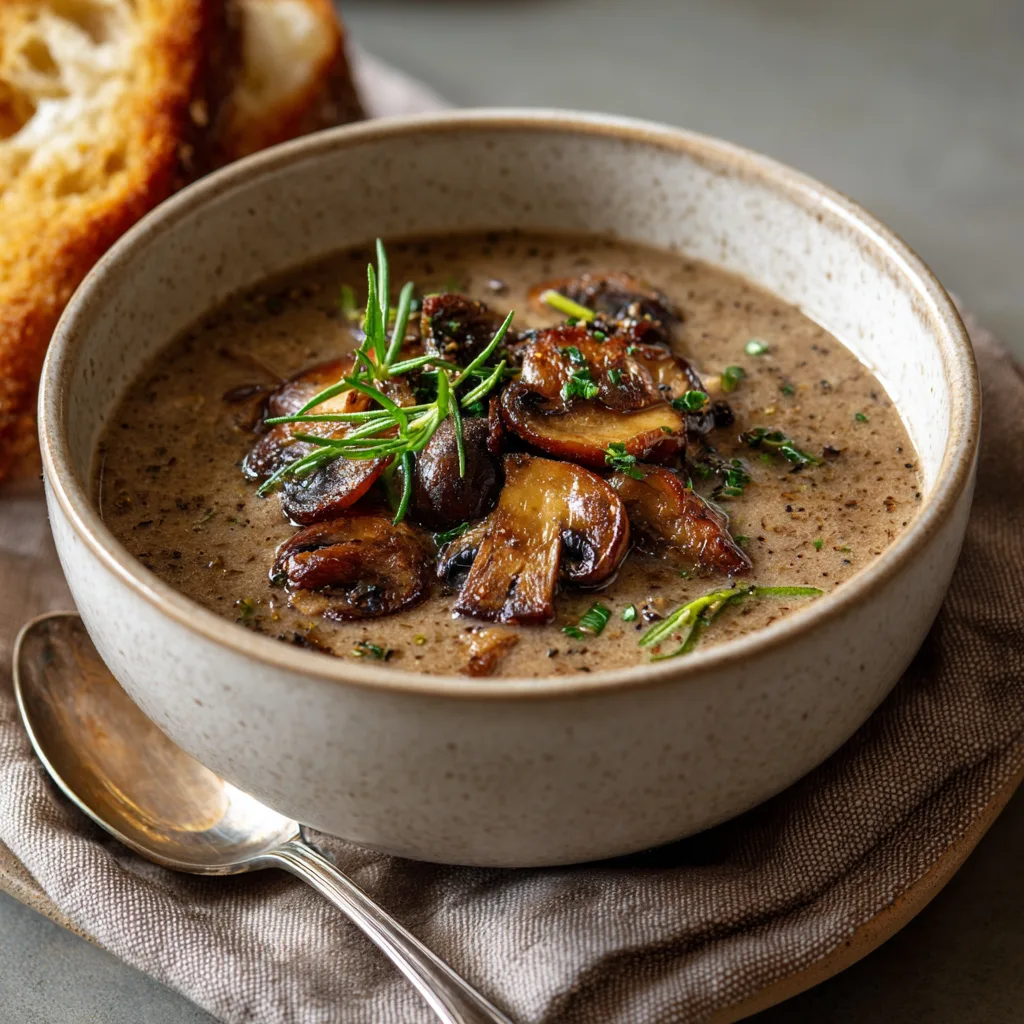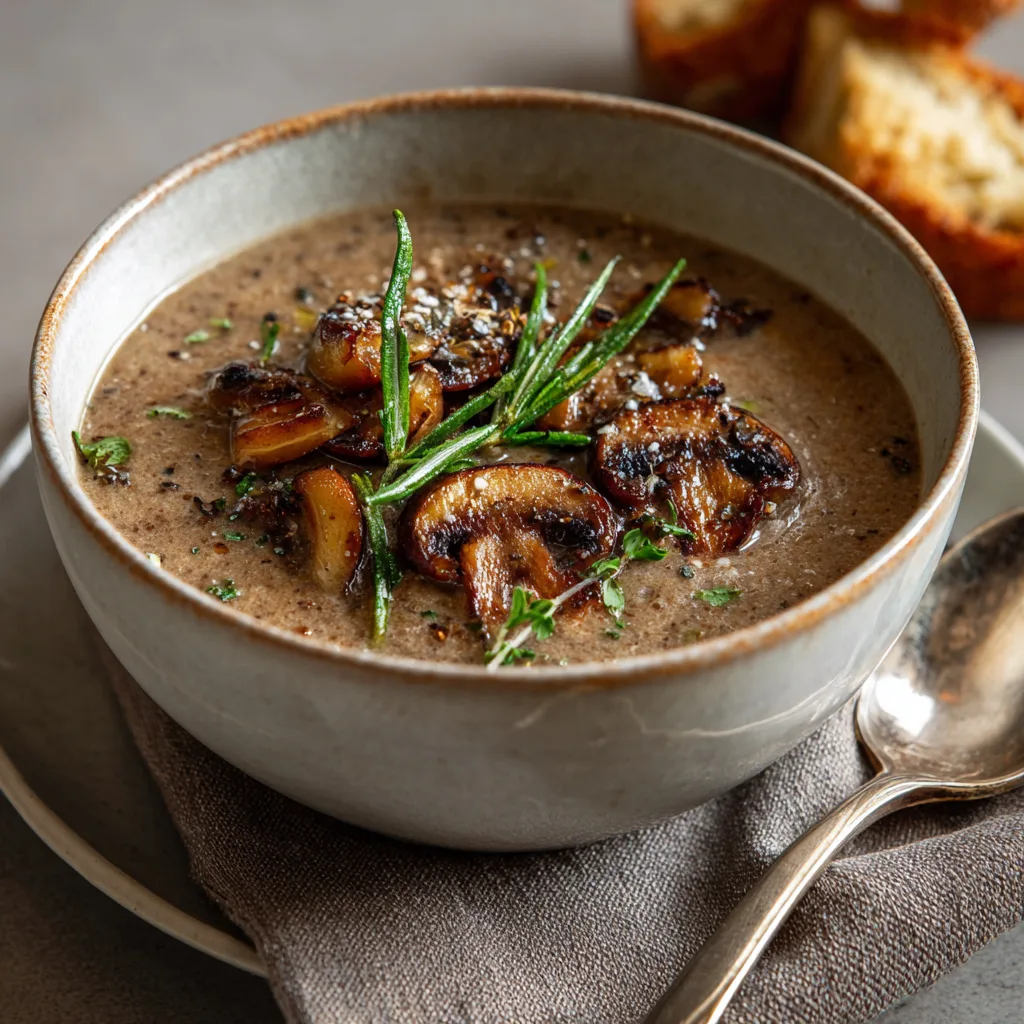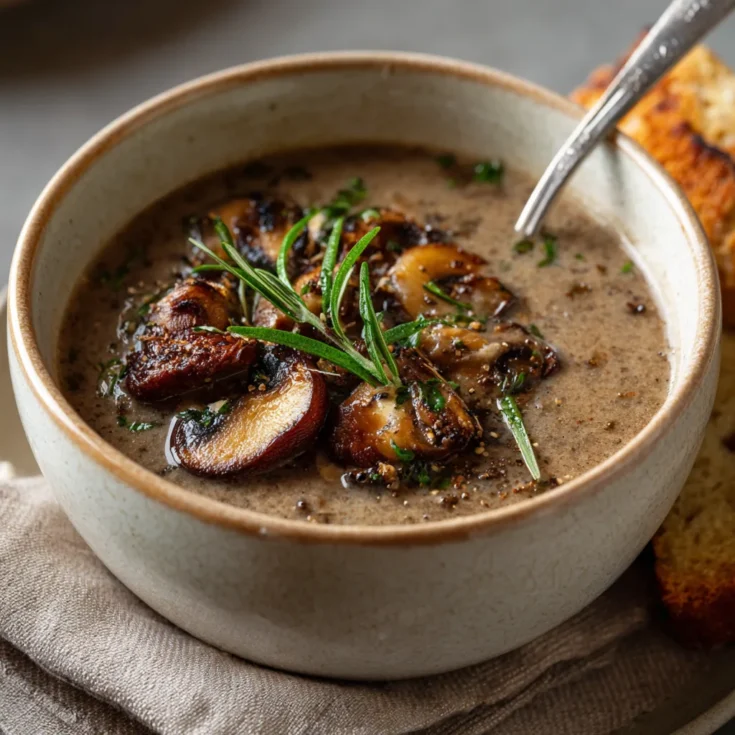Comforting Mushroom Soup – A Warm and Nourishing Classic
Mushroom soup earns its place as one of the most comforting dishes thanks to its rich, earthy flavors and soothing warmth. Every spoonful delivers a creamy texture paired with the deep umami notes that mushrooms naturally offer. This combination creates a bowl that feels like a gentle hug on chilly days or when you need a cozy pick-me-up.
Over time, mushroom soup has grown in popularity worldwide. From humble home kitchens to gourmet restaurants, it appeals to many because it balances simplicity with depth. The soup’s versatility allows it to suit various tastes, dietary preferences, and occasions, making it a go-to comfort food.
Historically, mushrooms have long been prized for their flavor and medicinal properties. Many cultures incorporated mushroom-based broths and soups into their traditional diets. For centuries, mushroom soup has symbolized nourishment and healing, reflecting its role beyond just a meal.
Mushroom soup shines especially during cold seasons. Its warmth helps fight off the chill, while the hearty ingredients provide lasting energy. Whether served as a starter or a main dish, it turns any meal into a satisfying experience that feels both indulgent and wholesome.
This article will explore everything you need to know about comforting mushroom soup. You’ll learn about the key ingredients that bring out its signature taste, discover easy variations to match your dietary needs, and find tips for perfecting your soup-making skills. Finally, a detailed recipe will guide you step-by-step to create your own bowl of cozy mushroom soup at home.
Essential Ingredients in Comforting Mushroom Soup: Types and Their Flavor Profiles
Choosing the right mushrooms shapes the soul of your comforting mushroom soup. Button mushrooms bring a mild, delicate flavor perfect for a subtle base. Cremini mushrooms offer a deeper earthiness, adding more complexity. Shiitake mushrooms introduce a smoky, woodsy note that intensifies the soup’s umami. Porcini mushrooms stand out with their robust and nutty taste, ideal for richer recipes. Oyster mushrooms add a soft texture with a mild sweetness, balancing heartier varieties. Combining these types can create layered, vibrant flavors that delight the palate.
The broth base plays a crucial role in shaping the soup’s character. Vegetable broth delivers a light, fresh canvas ideal for vegetarian or vegan versions. Chicken broth enriches the soup with savory warmth and depth, while beef broth offers a bold, hearty foundation. Selecting the broth depends on your dietary preference and the flavor intensity you desire.
Cream or dairy alternatives contribute to the soup’s luxurious texture. Heavy cream and milk add richness and smoothness, creating that classic velvety mouthfeel. For dairy-free options, coconut milk imparts a subtle sweetness and creamy consistency. Cashew cream offers a neutral, silky alternative that blends seamlessly without overpowering the mushroom flavors.
Aromatics and seasonings like garlic, onions, thyme, parsley, and bay leaves infuse the soup with fragrant layers. Garlic and onions provide a savory backbone, while thyme and bay leaves bring herbal notes that brighten the earthy mushrooms. Fresh parsley adds a final burst of color and subtle freshness when garnished.
Thickening agents are essential for achieving the ideal soup consistency. Flour and cornstarch create a smooth, slightly thickened broth without masking flavors. Potatoes, when cooked and blended, add natural creaminess and body. Pureed mushrooms enhance thickness while intensifying the mushroom essence, preserving the soup’s authentic taste.
How Each Ingredient Enhances Texture and Flavor in Mushroom Soup
Mushrooms deliver an intense umami richness that defines this soup. Their natural glutamates elevate the overall savoriness, making each bite deeply satisfying. Cream or dairy substitutes contribute essential creaminess, balancing the mushrooms’ earthiness with softness and smooth texture.
Herbs and spices enrich the aroma and deepen the flavor profile. Thyme adds warmth and subtle complexity, while bay leaves offer mild bitterness that cuts through richness. Fresh parsley brightens the soup’s finish, keeping the taste lively and fresh.
The choice of broth dramatically impacts the soup’s final character. A light vegetable broth allows mushroom flavors to shine, making the soup delicate and refreshing. Chicken or beef broth adds boldness and a robust base, perfect for those who prefer a heartier experience.
Together, these ingredients build a comforting mushroom soup that delights with balanced textures and rich, layered flavors. Each component works harmoniously to create a warm and nourishing bowl that comforts the senses.
Preparing Mushrooms for Soup: Cleaning and Slicing Techniques
Proper preparation of mushrooms lays the foundation for a delicious, comforting mushroom soup. Start by gently brushing off any dirt using a soft mushroom brush or a damp paper towel. Avoid soaking mushrooms in water, as they absorb moisture and become soggy. After cleaning, slice the mushrooms evenly to ensure they cook uniformly. Thinner slices cook faster and release more flavor, while thicker cuts add texture and substance. For varieties like shiitake or porcini, remove tough stems before slicing, as they can be woody and unpleasant to eat.
To maximize flavor, consider roasting or sautéing your mushrooms before adding them to the soup. Roasting intensifies the earthy taste and adds caramelized notes by drawing out natural sugars. Spread the mushrooms on a baking sheet, drizzle lightly with oil, and roast at high heat until golden. Alternatively, sauté mushrooms in a hot pan with a bit of oil or butter, stirring occasionally to promote browning. This method creates a rich base and preserves moisture. Both techniques develop the deep umami flavor that defines mushroom soup.
Cooking Techniques for the Perfect Comforting Mushroom Soup Base
Start building your soup by sautéing aromatics such as onions and garlic. Heat oil or butter in a large pot over medium heat, then add finely chopped onions and minced garlic. Cook until translucent and fragrant, about 3-5 minutes. This step releases sweetness and adds depth to the soup.
Next, add your prepared mushrooms to the pot. Cook until they release their juices and begin to brown, which enhances the soup’s flavor. Pour in your chosen broth—vegetable, chicken, or beef—and bring the mixture to a gentle simmer. Simmering allows flavors to meld and creates a rich, savory base.
Once the broth simmers, stir in cream or dairy alternatives to add smoothness and body. To thicken the soup, mix a small amount of flour or cornstarch with cold water to form a slurry, then gradually whisk it into the soup. Alternatively, blend a portion of the soup or add pureed potatoes for natural thickness.
Taste the soup and season with salt, pepper, and herbs like thyme or bay leaves. Adjust seasoning carefully to balance earthiness with creaminess. If the soup feels too thick, add broth or water to reach your preferred consistency.
Variations and Enhancements for a Customized Mushroom Soup
You can easily tailor mushroom soup to suit your preferences or dietary needs. Instead of alcohol, enrich the soup’s flavor with a splash of vegetable or mushroom broth for added depth.
Incorporate extra vegetables like leeks, carrots, or celery. These add sweetness and texture, making the soup heartier and more colorful. Sauté the vegetables alongside the aromatics to soften them before adding broth.
For vegan or gluten-free versions, substitute dairy cream with coconut milk, cashew cream, or oat milk. Use gluten-free flour or cornstarch as your thickener, and choose vegetable broth for the base.
To boost protein, add cooked chicken pieces for a non-vegetarian option or tofu cubes for plant-based protein. Gently stir these in after simmering to warm without breaking them apart.
With these steps and ideas, you can create a comforting mushroom soup that fits your taste and lifestyle while delivering rich, layered flavors in every bowl.
How to Serve Comforting Mushroom Soup: Perfect Pairings and Garnishes
Serving mushroom soup offers a chance to elevate its comforting qualities. Pair the soup with crusty bread or warm garlic toast to add crunch and soak up every flavorful drop. Crisp croutons sprinkled on top provide delightful texture contrasts. For a lighter side, fresh green salads with a tangy vinaigrette complement the soup’s creamy richness, balancing the meal.
Garnishing your soup enhances both flavor and presentation. Fresh herbs like parsley, chives, or thyme brighten the dish with vibrant color and subtle aroma. A drizzle of truffle oil—used sparingly—adds an extra layer of earthy sophistication. For a crispy topping, sauté thinly sliced mushrooms until golden and sprinkle them over the soup. These garnishes bring fresh, textural, and aromatic elements that transform a simple bowl into an elegant experience.
Storing and Reheating Comforting Mushroom Soup: Keeping Flavor and Texture Intact
To store leftover mushroom soup safely, let it cool completely before transferring it to an airtight container. Refrigerate for up to three to four days to maintain freshness. Avoid leaving soup at room temperature for extended periods to prevent bacterial growth.
When reheating, warm the soup gently over low to medium heat on the stovetop. Stir frequently to distribute heat evenly and prevent scorching. If the soup thickened too much in the fridge, add a splash of broth, water, or dairy alternative to restore its creamy consistency without diluting the flavor.
Freezing mushroom soup is possible, but texture may change slightly. For best results, freeze soup in portion-sized containers with some headspace for expansion. Thaw overnight in the refrigerator before reheating slowly on the stove. Avoid using a microwave for reheating, as it can cause uneven heating and affect the soup’s texture. These storage and reheating tips help you enjoy your comforting mushroom soup anytime without losing its signature taste and smoothness.





